
Clara Lou "Ann" Sheridan was an American actress and singer. She is best known for her roles in the films San Quentin (1937) with Humphrey Bogart, Angels with Dirty Faces (1938) with James Cagney and Bogart, They Drive by Night (1940) with George Raft and Bogart, City for Conquest (1940) with Cagney and Elia Kazan, The Man Who Came to Dinner (1942) with Bette Davis, Kings Row (1942) with Ronald Reagan, Nora Prentiss (1947), and I Was a Male War Bride (1949) with Cary Grant.

The Saint Strikes Back is a 1939 American crime film directed by John Farrow. It marks the second cinematic incarnation of the antihero crimefighting character Simon Templar, alias "The Saint". George Sanders replaced Louis Hayward, who had played the Saint in The Saint in New York. The movie was produced by RKO and also featured Wendy Barrie as female gang leader Val Travers. Barrie would appear in two more Saint films, playing different roles each time, though not in the next film in the series, The Saint in London. This was the second of eight films in RKO's film series about The Saint, and the first of five with Sanders in the title role.

John Villiers Farrow, KGCHS was an Australian film director, producer, and screenwriter. Spending a considerable amount of his career in the United States, in 1942 he was nominated for the Academy Award for Best Director for Wake Island, and in 1957 he won the Academy Award for Best Adapted Screenplay for Around the World in Eighty Days. He had seven children by his wife, actress Maureen O'Sullivan, including actress Mia Farrow.

John Beach Litel was an American film and television actor.
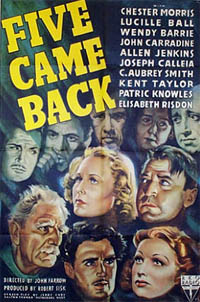
Five Came Back is a 1939 American black-and-white melodrama from RKO Radio Pictures produced by Robert Sisk, directed by John Farrow, written by Jerry Cady, Dalton Trumbo, and Nathanael West, and starring Chester Morris and Lucille Ball. The film was photographed by cinematographer Nicholas Musuraca. Although considered a B movie, the positive notices received by Ball helped launch her career as an A-list actress. Five Came Back is considered a precursor of the disaster film genre. The supporting cast features Wendy Barrie, John Carradine, C. Aubrey Smith, Kent Taylor, and Patric Knowles.
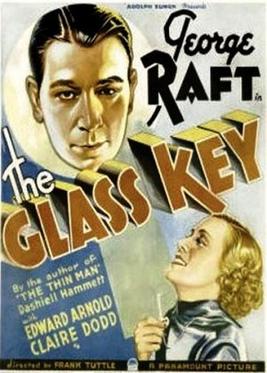
The Glass Key, released in 1935, was based upon the 1931 suspense novel The Glass Key by Dashiell Hammett, directed by Frank Tuttle, starring George Raft and featuring Edward Arnold, Claire Dodd, Guinn "Big Boy" Williams and Ray Milland. Ann Sheridan has a brief speaking role as Raft's character's nurse in their first film together.
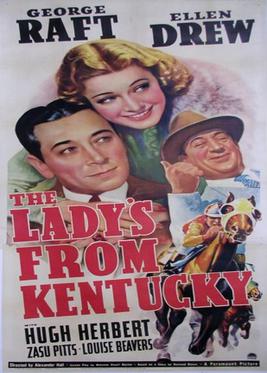
The Lady's from Kentucky is a 1939 film directed by Alexander Hall and starring George Raft and Ellen Drew. It was written by Malcolm Stuart Boylan from a story by Rowland Brown. The screenplay involves a failing bookie (Raft) who becomes half owner of a racehorse, with a Kentucky lady (Drew) owning the other half. ZaSu Pitts plays a supporting role.
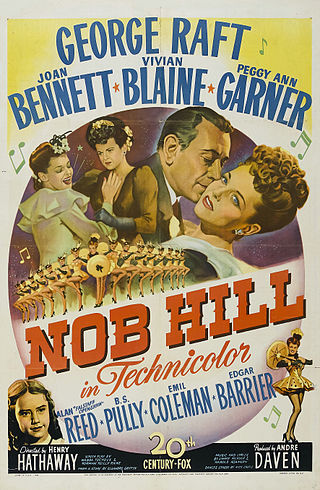
Nob Hill is a 1945 Technicolor film about a Barbary Coast, San Francisco, United States saloon keeper, starring George Raft and Joan Bennett. Part musical and part drama, the movie was directed by Henry Hathaway. It remains one of Raft's lesser known movies even though it was a big success, in part because it was a musical.

Mary Maguire was an Australian-born actress who briefly became a Hollywood and British film star in the late 1930s.
Seton Ingersoll Miller was an American screenwriter and producer. During his career, he worked with film directors such as Howard Hawks and Michael Curtiz. Miller received two Oscar nominations and won once for Best Screenplay for the 1941 fantasy romantic comedy film, Here Comes Mr. Jordan, along with Sidney Buchman.
Sorority House is a 1939 American drama film starring Anne Shirley and James Ellison. The film was directed by John Farrow and based upon the Mary Coyle Chase play named Chi House.

Black Widow is a 1954 American DeLuxe Color mystery film in CinemaScope, with elements of film noir, written, produced, and directed by Nunnally Johnson, based on the 1952 novel of the same name by Patrick Quentin. The film stars Ginger Rogers, Van Heflin, Gene Tierney, and George Raft.
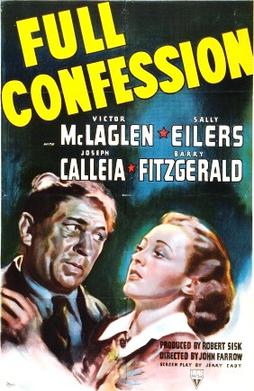
Full Confession is a 1939 United States proto film-noir, crime drama film made by RKO Radio Pictures. It was directed by John Farrow from an adaptation by Jerome Cady of Leo Birinski's story. The film stars Victor McLaglen, Sally Eilers, Barry Fitzgerald and Joseph Calleia.

It All Came True is a 1940 American musical comedy crime film starring Ann Sheridan as a fledgling singer and Humphrey Bogart, who was third-billed on movie posters, as a gangster who hides from the police in a boarding house. It is based on the Louis Bromfield novel Better Than Life. Sheridan introduced the hit song "Angel in Disguise". The picture was produced by Mark Hellinger and directed by Lewis Seiler. The cast also featured Jeffrey Lynn as the leading man, Zasu Pitts, and Una O'Connor.
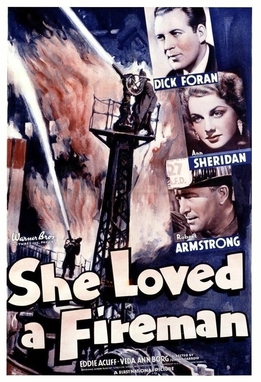
She Loved a Fireman is a 1937 American action drama film directed by John Farrow and starring Dick Foran and Ann Sheridan.

Women in the Wind is a 1939 film directed by John Farrow and starring Kay Francis, William Gargan and Victor Jory. The plot concerns women pilots competing in the so-called "Powder Puff Derby", an annual transcontinental air race solely for women.

Broadway Musketeers is a 1938 American musical drama film directed by John Farrow for Warner Bros. Starring Margaret Lindsay, Ann Sheridan and Marie Wilson as three women who grew up in an orphanage and cross paths later in life, it is a remake of the Warners pre-code crime drama film, Three on a Match.

Comet over Broadway is a 1938 American drama film starring Kay Francis, Ian Hunter and Donald Crisp. It was produced and released by Warner Brothers. John Farrow stepped in as director when Busby Berkeley became ill, but Farrow was uncredited on the film.

Men in Exile is a 1937 American drama film directed by John Farrow. A "B" movie from Warner Bros, it was the first feature Farrow directed. It is essentially a remake of their 1931 melodrama Safe in Hell, albeit with the lead switched from female to male, with some plot changes as a result.

Alcatraz Island is a 1937 American drama film directed by William C. McGann and written by Crane Wilbur. The film stars John Litel, Ann Sheridan, Mary Maguire, Gordon Oliver, Dick Purcell and Ben Welden. The film was released by Warner Bros. on November 6, 1937.


















